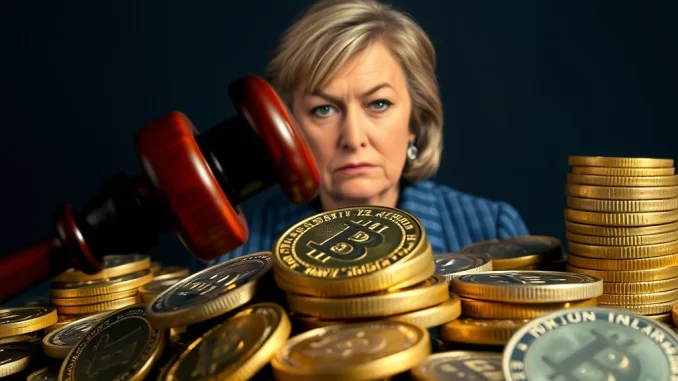
Are you holding stablecoins thinking they are as safe as U.S. dollars? Think again. U.S. Securities and Exchange Commission (SEC) Commissioner Caroline A. Crenshaw is raising alarm bells, asserting that the SEC’s own analysis is dangerously downplaying the inherent stablecoin risks within the current market. Her powerful dissent shines a light on critical oversights that could impact every crypto investor. Let’s dive into why this SEC commissioner is so concerned and what it means for the future of stablecoins.
Why is SEC Commissioner Crenshaw Challenging the SEC’s Stablecoin Analysis?
Commissioner Crenshaw isn’t just voicing a casual opinion; she’s directly challenging the findings of the SEC’s Division of Corporation Finance. According to Crenshaw, this division’s analysis falters in a crucial area: the classification of certain stablecoins as securities. She argues that the staff’s report is riddled with inaccuracies, both legally and factually, painting a misleadingly benign picture of the U.S. dollar-pegged stablecoin market. What exactly are these inaccuracies she’s pointing out?
- Mischaracterization of Stablecoin Risks: Crenshaw believes the analysis significantly underestimates the risks associated with stablecoins, especially concerning their peg to the U.S. dollar and the mechanisms meant to maintain this peg.
- Overlooking Intermediary Reliance: A core point of contention is the analysis’s failure to adequately address the risks stemming from the heavy reliance on intermediaries for stablecoin distribution and redemption.
- Inaccurate Legal and Factual Basis: Commissioner Crenshaw suggests the very foundation of the division’s analysis is flawed, leading to an underestimation of the regulatory requirements that should apply to stablecoins.
In essence, Crenshaw is saying the SEC’s internal analysis isn’t just a minor disagreement; it’s a fundamental misunderstanding of the cryptocurrency risks posed by stablecoins and how they operate in the real world.
The Hidden Danger: Reliance on Unregistered Intermediaries
Commissioner Crenshaw’s most pointed critique revolves around the role of intermediaries. Did you know that over 90% of USD stablecoins rely on intermediaries for their distribution and, crucially, their redemption? This is where the potential for trouble escalates.
She emphasizes that these intermediaries, often unregistered entities, become critical chokepoints in the stablecoin ecosystem. While stablecoin issuers might implement risk-reducing measures, these efforts can be undermined if the intermediaries themselves are not robust and reliable. Imagine a scenario:
- You hold a significant amount of a USD-pegged stablecoin.
- You decide to redeem your stablecoins for actual U.S. dollars.
- You initiate the redemption process through an intermediary, perhaps an exchange or a platform.
- But what if this intermediary faces financial difficulties, operational failures, or even regulatory issues?
Crenshaw warns that in such cases, stablecoin holders could be left without recourse. The promise of a 1:1 peg to the U.S. dollar becomes hollow if the very entities facilitating redemption are unable to fulfill their obligations. This dependency on intermediaries is a significant, often overlooked, aspect of stablecoin regulation.
Are Stablecoins Securities? Why Does It Matter?
At the heart of Crenshaw’s argument is the question of whether certain stablecoins should be classified as securities under U.S. law. This isn’t just a technical legal debate; it has profound implications for how stablecoins are regulated and the protections afforded to investors.
If stablecoins are deemed securities, they would fall under the SEC’s jurisdiction, subjecting them to a more rigorous regulatory framework. This could mean:
| Regulation Aspect | Implications for Stablecoins as Securities |
|---|---|
| Registration Requirements | Issuers might need to register with the SEC, increasing transparency and accountability. |
| Disclosure Obligations | More detailed and regular disclosures about reserves, risks, and operations would be mandated. |
| Investor Protection | Securities laws offer various investor protections, including recourse against fraud and misrepresentation. |
Commissioner Crenshaw’s stance suggests she believes that at least some stablecoins exhibit characteristics that warrant their classification as securities. By not classifying them as such, she argues, the SEC might be failing in its duty to protect investors from potential harm within the evolving cryptocurrency market.
What’s Next for Stablecoin Regulation?
Commissioner Crenshaw’s public disagreement with the SEC’s division highlights the ongoing internal debate within regulatory bodies regarding stablecoins. It signals that the path forward for stablecoin regulation is far from settled. Her outspoken concerns could potentially:
- Influence Future SEC Policy: Crenshaw’s dissent could prompt further scrutiny and re-evaluation of the SEC’s approach to stablecoins.
- Fuel Legislative Action: Her arguments might resonate with lawmakers considering legislation related to digital assets and stablecoins.
- Increase Public Awareness: By bringing these issues to the forefront, she is educating the public and the crypto industry about the nuanced risks associated with stablecoins.
For crypto investors, Commissioner Crenshaw’s perspective serves as a critical reminder: stablecoins are not risk-free. Understanding the complexities of their mechanisms, the role of intermediaries, and the ongoing regulatory discussions is paramount for making informed decisions in the volatile world of cryptocurrencies.
Conclusion: A Wake-Up Call for Stablecoin Investors
Commissioner Caroline A. Crenshaw’s argument is a powerful wake-up call. It challenges the prevailing narrative that stablecoins are inherently safe and low-risk. Her critique of the SEC’s analysis underscores the hidden vulnerabilities within the stablecoin ecosystem, particularly the reliance on intermediaries. As the regulatory landscape for cryptocurrencies continues to evolve, Crenshaw’s voice adds a crucial perspective, urging for a more thorough and cautious approach to stablecoin regulation. For investors, this means exercising due diligence, understanding the risks involved, and staying informed about the ongoing regulatory developments that will shape the future of stablecoins and the broader crypto market. The message is clear: proceed with caution and be aware of the potential pitfalls lurking beneath the surface of seemingly stable digital assets.



